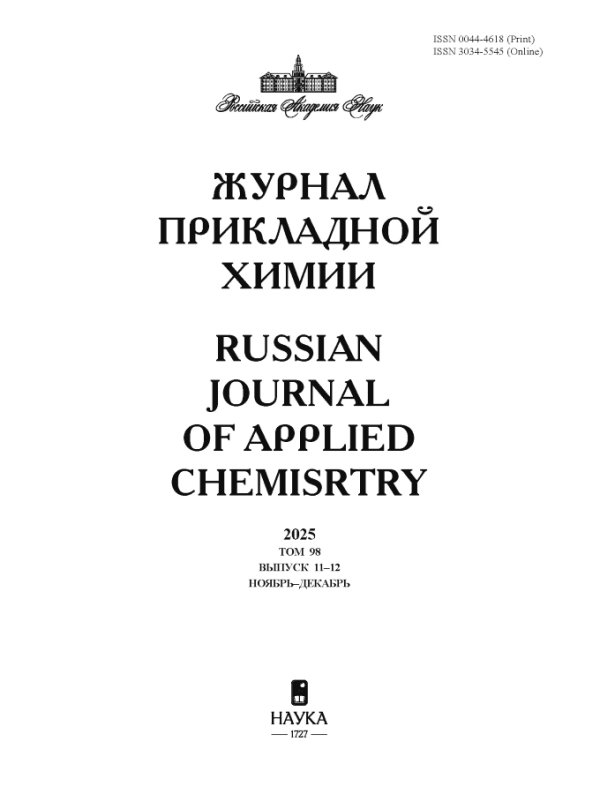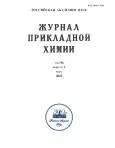Physical-mechanical Properties and Morphology of Lignocellulose Powder Modifiers for Vulcanized Rubbers
- Authors: Kuvshinova L.A.1, Udoratina E.V.1, Karaseva Y.S.2, Cherezova E.N.2
-
Affiliations:
- Institute of Chemistry, Federal Research Center Komi Scientific Center, Ural Branch, Russian Academy of Sciences
- Kazan National Research University of Technology
- Issue: Vol 96, No 3 (2023)
- Pages: 252-263
- Section: Articles
- URL: https://journals.rcsi.science/0044-4618/article/view/247283
- DOI: https://doi.org/10.31857/S0044461823030039
- EDN: https://elibrary.ru/PFOSDX
- ID: 247283
Cite item
Full Text
Abstract
Powder lignocellulose modifiers for vulcanized rubbers were prepared from secondary paper resources (recycled cardboard) treated with TiCl4 in hexane. The diffraction patterns, IR spectra, and morphological characteristics of the materials obtained, including the geometric characteristics and length distribution of fibers, were analyzed. The content of titanium, lignin, and carbonyl and carboxyl groups and the bulk density of the material were determined. The presence of up to 5 wt parts of powder modifiers per 100 wt parts of rubber in the rubber stock favors preservation of physicomechanical properties of vulcanized rubbers both before and after accelerated thermal oxidative aging at 100°C for 72 h, enhancing the resin–metal cord adhesion and thus prolonging the operation life of the vulcanized rubbers.
About the authors
L. A. Kuvshinova
Institute of Chemistry, Federal Research Center Komi Scientific Center, Ural Branch, Russian Academy of Sciences
Email: acjournal.nauka.nw@yandex.ru
Syktyvkar, 167000, Komi Republic, Russia
E. V. Udoratina
Institute of Chemistry, Federal Research Center Komi Scientific Center, Ural Branch, Russian Academy of Sciences
Email: acjournal.nauka.nw@yandex.ru
Syktyvkar, 167000, Komi Republic, Russia
Yu. S. Karaseva
Kazan National Research University of Technology
Email: acjournal.nauka.nw@yandex.ru
Kazan, 420015, Tatarstan, Russia
E. N. Cherezova
Kazan National Research University of Technology
Author for correspondence.
Email: acjournal.nauka.nw@yandex.ru
Kazan, 420015, Tatarstan, Russia
References
- Муллина Э. Р., Мишурина О. А., Нигматуллина Л. И., Ишкуватова А. Р. Влияние процесса вторичной переработки макулатуры на бумагообразующие свойства целлюлозного сырья // Междунар. журн. прикладных и фундаментальных исследований. 2015. № 4. С. 32-34. https://www.elibrary.ru/tnzkbb
- Слаутин Д. В., Теплоухова М. В., Адраковский Р. Э. Повышение прочности бумаги, изготовленной из макулатурной массы // Вестн. Перм. нац. исслед. политехн. ун-та. Хим. технология и биотехнология. 2018. № 1. С. 113-135. https://doi.org/10.15593/2224-9400/2018.1.10
- Кожевников С. Ю., Ковернинский И. Н., Канарский А. В. Влияние циклов переработки макулатуры на длину волокон и качество бумаги и картона // Вестн. технол. ун-та. 2016. Т. 19. № 5. С. 81-85. https://www.elibrary.ru/vnyvel
- Deshwal G. K., Panjagari N. R., Alam T. An Overview of paper and paper based food packaging materials: Health safety and environmental concerns //j. Food Sci. Technol. 2019. V. 56. P. 4391-4403. https://doi.org/10.1007/s13197-019-03950-z
- Lozada E. R., Gutiérrez Aguilar C. M., Jaramillo Carvalho J. A., Sánchez J. C., Barrera Torres G. Vegetable cellulose fibers in natural rubber composites // Polymers. 2023. V. 15. N 13. P. 1-20. https://doi.org/10.3390/polym15132914
- Aaliya B., Sunooj K. V., Lackner M. Biopolymer composites: A Review // Int. J. Biobased Plastics. 2021. V. 3. N 1. P. 40-84. https://doi.org/10.1080/24759651.2021.1881214
- Горбачев А. В., Файзуллин И. З., Вольфсон С. И., Канарский А. В., Захаров И. В., Казаков Ю. М. Композиционный материал на основе полиолефинов и модифицированных растительных наполнителей // Пласт. массы. 2023. № 1 (1-2). С. 48-52. https://doi.org/10.35164/0554-2901-2023-1-2-48-52
- Zhou Y., Fan M., Chen L., Zhuang J. Lignocellulosic fibre mediated rubber composites: An Overview // Composites. Part B: Engineering. 2015. V. 76. P. 180- 191. https://doi.org/10.1016/j.compositesb.2015.02.028
- Захаров В. П., Шуршина А. С., Кулиш Е. И. Изучение вязкоупругих характеристик вторичного полимерного сырья в присутствии природных наполнителей растительного происхождения // Конденс. среды и межфаз. границы. 2020. Т. 22. № 1. С. 11-17. https://doi.org/10.17308/kcmf.2020.22/2471
- Vladkova T. G., Dineff P. D., Gospodinova D. N., Avramova I. Wood flour: New filler for the rubber processing industry. IV. Cure characteristics and mechanical properties of natural rubber compounds filled by non-modified or corona treated wood flour //j. Appl. Polym. Sci. 2006. V. 101. P. 651-658. https://doi.org/10.1002/app.23730
- Zhou Y., Fan M., Chen L.Interface and bonding mechanisms of plant fibre composites: An Overview // Composites. Part B: Engineering. 2016. V. 101. P. 31-45. http://dx.doi.org/10.1016/j.compositesb.2016.06.055
- Li M., Pu Y., Thomas V. M., Yoo C. G., Ozcan S., Deng Y., Nelson K., Ragauskas A. J. Recent advancements of plant-based natural fiber-reinforced composites and their applications // Composites. Part B: Engineering. 2020. V. 200. P. 1-20. https://doi.org/10.1016/j.compositesb.2020.108254
- Roy K., Debnath S. C., Potiyaraj P. A Critical review on the utilization of various reinforcement modifiers in filled rubber composites //j. Elastomers Plast. 2019. V. 52. N 2. P. 167-193. https://doi.org/10.1177/0095244319835869
- Roy K., Debnath S. C., Pongwisuthiruchte A., Potiyaraj P. Natural rubber/microcrystalline cellulose composites with epoxidized natural rubber as compatibilizer // Rubber Chem. Technol. 2019. V. 92. N 2. P. 378-387. https://doi.org/10.5254/rct.19.81533
- Roy K., Potiyaraj P. Development of high performance microcrystalline cellulose based natural rubber composites using maleated natural rubber as compatibilizer // Cellulose. 2017. V. 25. N 2. P. 1077- 1087. https://doi.org/10.1007/s10570-017-1613-2
- Bokobza L. Natural rubber nanocomposites: A Review // Nanomaterials. 2019. V. 9. N 1. P. 12-32. https://doi.org/10.3390/nano9010012
- Fei Y., Fang W., Zhong M., Jin J., Fan P., Yang J., Fei Z., Chen F., Kuang T. Morphological structure, rheological behavior, mechanical properties and sound insulation performance of thermoplastic rubber composites reinforced by different inorganic fillers // Polymers. 2018. V. 10. N 3. P. 276-287. https://doi.org/10.3390/polym10030276
- Ranta-Korpi M., Konttinen J., Saarimaa A., Rodriguez M., Vainikka P. Ash forming elements in plastics and rubbers / University of Jyväskylä. Kuopio: VTT Technology, 2014. P. 23-26. https://publications. vtt.fi/pdf/technology/2014/T186.pdf
- Nabil H., Rathnayake W. G. I. U., Ismail H. Nano-sized TiO2-reinforced natural rubber composites prepared by latex compounding method //j. Vinyl Addit. Technol. 2017. V. 23. N 3. P. 200-209. https://doi.org/10.1002/vnl.21497
- Kumaua V., Kumar A., Chhatra R. K., Lee D. J. Studies on high performance rubber composites by incorporating titanium dioxide particles with different surface area and particle size // Nanofabrication. 2022. V. 7. P. 104-115. https://doi.org/10.37819/nanofab.000.200
- Roy K. J., Sikdar D., Mandal S. K., Debnach S. C. Surface modification of nano titanium dioxide (TiO2) by cationic surfactanys and investigation of its effect on the properties of natural rubber (NR) nanocomposites // Rubber Chem. Technol. 2020. V. 93. N 2. P. 346-359. https://doi.org/10.5254/rct.19.84831
- Cazan C., Enesca A., Andronic L. Synergic effect of TiO2 filler on the mechanical properties of polymer nanocomposites // Polymers. 2021. V. 13. N 12. P. 1-24. https://doi.org/10.3390/polym13122017
- Пат. РФ 2680046 (опубл. 2019). Порошковый лигноцеллюлозный материал на основе неоргано-лигноцеллюлозного гибрида.
- Фролова С. В., Кувшинова Л. А., Рязанов М. А., Кучин А. В. Влияние тетрахлорида титана, применяемого для получения порошковой целлюлозы, на кислотно-основные свойства ее суспензий // Химия в интересах устойчив. развития. 2012. Т. 20. № 2. С. 243-247. https://www.elibrary.ru/oxphuz
- Мелех Н. В., Фролова С. В., Алешина Л. А. Рентгенографический анализ порошковых целлюлоз, полученных с применением кислот Льюиса // Высокомолекуляр. соединения. 2014. Т. 56. № 2. С. 134-141. https://doi.org/10.7868/S2308112014020102
- Кувшинова Л. А., Манахова Т. Н. Изменение морфологических особенностей целлюлозы под воздействием тетрахлорида титана // Химия раст. сырья. 2014. № 2. С. 29-34. https://doi.org/10.14258/jcprm.1402029
- Пенкин А. А., Казаков Я. В. Структурно-морфологические свойства вторичного волокна из влагопрочного сырья при мягком размоле. Часть 2. Характеристика волокнистой мелочи //Изв. вузов. Лесн. журн. 2023. № 4. С. 169-179. https://doi.org/10.37482/0536-1036-2023-4-169-179
Supplementary files










